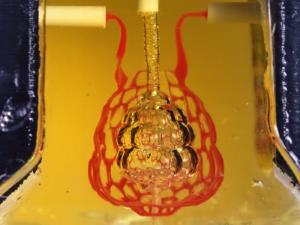



Date:06/05/19
 Bioengineers at Rice University have made a breakthrough in bioprinting of tissues. The team has been able to create entangled vascular networks that can mimic the body’s natural passageways for blood, air, lymph, and other vital fluids. Scientists created a proof-of-principal that is a hydrogel model of a lung-mimicking air sac that has airways delivering oxygen to surrounding blood vessels.
Bioengineers at Rice University have made a breakthrough in bioprinting of tissues. The team has been able to create entangled vascular networks that can mimic the body’s natural passageways for blood, air, lymph, and other vital fluids. Scientists created a proof-of-principal that is a hydrogel model of a lung-mimicking air sac that has airways delivering oxygen to surrounding blood vessels.
The team has also conducted experiments in mice that implant bioprinted constructs that have liver cells into the mice. The team says that one of the biggest roadblocks to generating functional tissue replacements has been the inability to print the complex vasculature that supplies nutrients to densely populated tissues.
The team notes that the organs they have designed contain independent vascular networks, like airways and blood vessels in the lung or bile ducts and blood vessels in the liver. The networks are physically and biochemically entangled, and the architecture is related to tissue function. The new process is the fist bioprinting technology that addresses the challenge of multivascularization in a “direct and comprehensive way.”
The end goal for the team is to be able to bioprint healthy and functional organs, and that is the goal that drives the team. Over 100,000 people are on transplant waiting lists in the U.S. alone. Those who receive an organ face a lifetime of immune-suppressing drugs to prevent organ rejection.
Bioprinting offers the chance to use the patients own cells to produce organs eliminating the need for donors and reducing the chance of rejection. The team believes that a ready supply of functional organs could be used to treat millions of people globally. Researchers believe that bioprinting will be a major component of medicine in the next two decades.
Researchers make a breakthrough in bioprinting human organs
 Bioengineers at Rice University have made a breakthrough in bioprinting of tissues. The team has been able to create entangled vascular networks that can mimic the body’s natural passageways for blood, air, lymph, and other vital fluids. Scientists created a proof-of-principal that is a hydrogel model of a lung-mimicking air sac that has airways delivering oxygen to surrounding blood vessels.
Bioengineers at Rice University have made a breakthrough in bioprinting of tissues. The team has been able to create entangled vascular networks that can mimic the body’s natural passageways for blood, air, lymph, and other vital fluids. Scientists created a proof-of-principal that is a hydrogel model of a lung-mimicking air sac that has airways delivering oxygen to surrounding blood vessels.The team has also conducted experiments in mice that implant bioprinted constructs that have liver cells into the mice. The team says that one of the biggest roadblocks to generating functional tissue replacements has been the inability to print the complex vasculature that supplies nutrients to densely populated tissues.
The team notes that the organs they have designed contain independent vascular networks, like airways and blood vessels in the lung or bile ducts and blood vessels in the liver. The networks are physically and biochemically entangled, and the architecture is related to tissue function. The new process is the fist bioprinting technology that addresses the challenge of multivascularization in a “direct and comprehensive way.”
The end goal for the team is to be able to bioprint healthy and functional organs, and that is the goal that drives the team. Over 100,000 people are on transplant waiting lists in the U.S. alone. Those who receive an organ face a lifetime of immune-suppressing drugs to prevent organ rejection.
Bioprinting offers the chance to use the patients own cells to produce organs eliminating the need for donors and reducing the chance of rejection. The team believes that a ready supply of functional organs could be used to treat millions of people globally. Researchers believe that bioprinting will be a major component of medicine in the next two decades.
Views: 462
©ictnews.az. All rights reserved.Similar news
- Azerbaijani project to monitor disease via mobile phones
- Innovative educational system to be improved under presidential decree
- NTRC prolongs license of two TV and radio organizations for 6 years
- Azerbaijan establishes e-registry for medicines
- Azerbaijani museum introduces e-guide
- Nar Mobile opens “Nar Dunyasi” sales and service center in Siyazan city
- International conference on custom electronic services held in Baku
- OIC secretary general to attend COMSTECH meeting in Baku
- Azerbaijan develops earthquake warning system
- New law to regulate transition to digital broadcasting in Azerbaijan
- Azerbaijani State Social Protection Fund introduces electronic digital signature
- Intellectual traffic management system in Baku to be commissioned in December
- Tax Ministry of Azerbaijan started receiving video-addresses
- World Bank recommends Azerbaijan to speed up e-service introduction in real estate
- Azerbaijan to shift to electronic registration of real estate





















